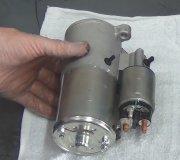If the starter spins the engine very slowly, even with a new battery, there is very little in the circuit that can cause trouble. You'll need a cheap digital voltmeter and a helper to turn the ignition switch.
Start by measuring the voltage between the two battery posts while your helper cranks the engine. The industry standard is it must remain above at least 9.6 volts, but realistically, you should have 10 - 11 volts with a new battery. If it is too low, either the battery is run down or the starter is drawing too much current. Connect a large battery charger with an ammeter. First charge the battery for half an hour at te lowest rate, then crank the engine with the charger still connected and turned on. If it cranks normally, we need to test the charging system. If it still cranks too slowly, feel one of the large battery cables. If it is hot, or if the ammeter on the charger goes real high, the starter is drawing excessive current. Either the starter is partially shorted or, less likely, there is internal engine damage.
If the voltage at the battery posts, (not the cable clamps), remains fairly high, say around 11 volts or higher, and it still cranks too slowly, we have to hunt for a connection problem. That is done by moving the voltmeter probes to different places in the circuit.
Holler back when you've made these checks.
Caradiodoc
Friday, January 22nd, 2021 AT 9:46 AM
(Merged)



